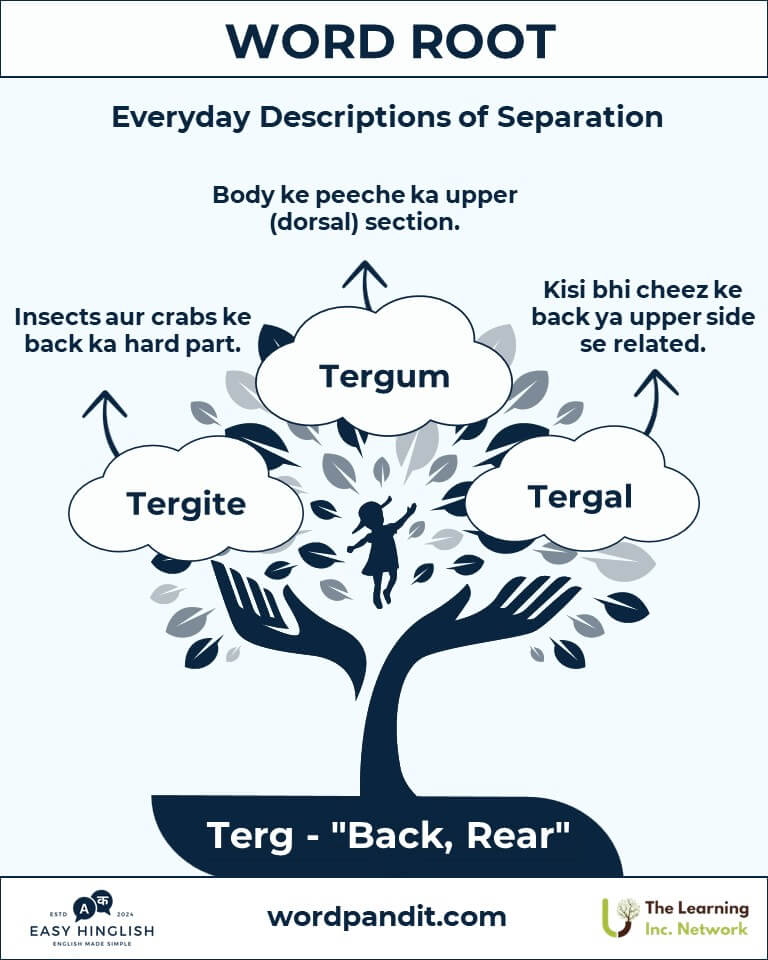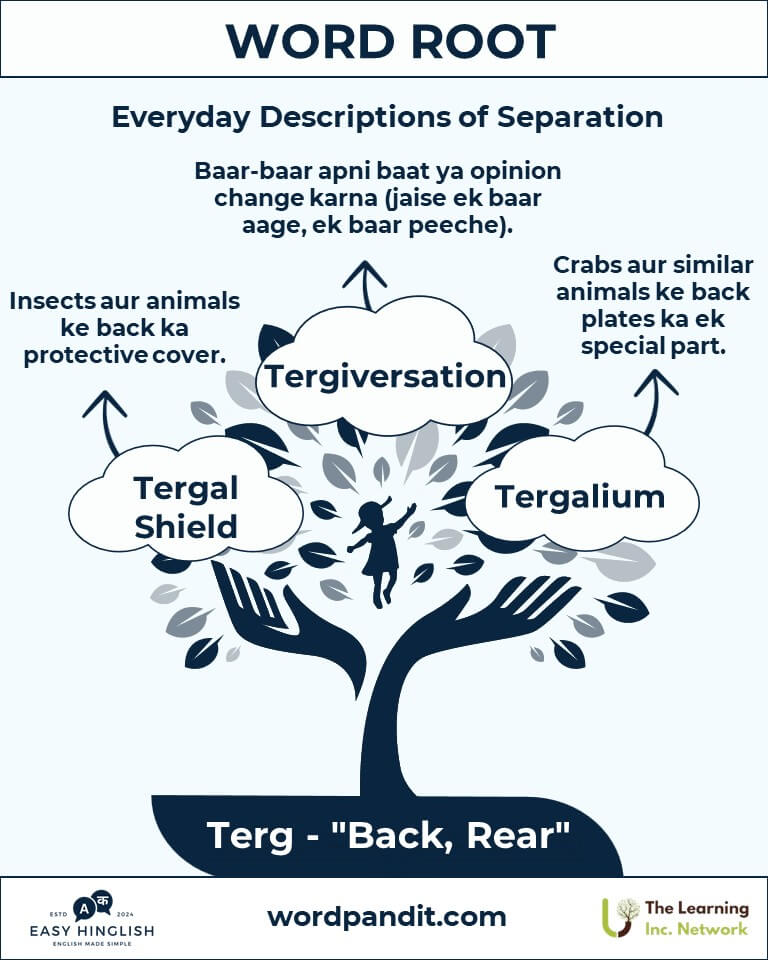Terg: The Backstory of a Root in Language and Science
(Terg: Language aur Science ke ek Root ki Kahani - टर्ग: भाषा और विज्ञान के एक रूट की कहानी)
Explore the fascinating root "terg," derived from Latin, meaning "back" (पीठ). It is used in fields like anatomy and biology to describe dorsal or posterior (पीछे) structures.

Table of Contents
- Introduction: The Essence of Terg
- Etymology and Historical Journey
- Mnemonic: Unlocking the Power of Terg
- Common Terg-Related Terms
- Terg Through Time
- Terg in Specialized Fields
- Illustrative Story: Terg in Action
- Cultural Significance of the Terg Root
- The Terg Family Tree
- FAQs About the Terg Word Root
- Test Your Knowledge: Terg Mastery Quiz
- Conclusion: The Living Legacy of Terg
Introduction: The Essence of Terg
(Terg ka Mool Arth - Terg का मूल अर्थ)
The root "Terg" means "back" (पीठ). It is used in anatomical descriptions and scientific terminology to define dorsal or posterior (पीछे) structures. Whether it is the exoskeleton of arthropods or the skeletal elements of vertebrates, "terg" has significance in multiple disciplines.

Etymology and Historical Journey
(Terg ki Utpatti aur Itihas - Terg की उत्पत्ति और इतिहास)
The root "terg" comes from the Latin word "tergum," which means "back" or "rear" (पीछे).
- Ancient Use: Initially referred to the back in human anatomy.
- Scientific Evolution: Over time, it was used to describe dorsal features in arthropods such as insects and crustaceans.
Mnemonic: Unlocking the Power of Terg
(Mnemonic ke Zariye Terg ko Yaad Rakhein - Terg को याद रखने का तरीका)
Imagine a turtle showing its back, with its sturdy shell providing protection. This is a perfect example of a "tergal shield."
Mnemonic Device: "Think Terg for the turtle’s back, a natural protective track."
Common Terg-Related Terms
(Terg-se Jude Common Shabdon ka Arth - Terg से जुड़े आम शब्द और उनके अर्थ)
- Tergal (ter-guhl): Related to the back or dorsal surface.
Example: "The beetle’s tergal plates protect its internal organs." - Tergite (ter-gite): A segment of an arthropod’s dorsal exoskeleton.
Example: "The structure of the tergite varies in each insect species." - Tergum (ter-gum): The dorsal part of an arthropod’s body segment.
Example: "The function of the tergum is to provide a shield for soft tissues." - Tergalium (ter-gal-ee-um): A specific part of the dorsal plates in some crustaceans.
Example: "Researchers studied the tergalium to understand crustacean evolution."
Terg Through Time
(Samay ke Saath Terg ka Safar - समय के साथ Terg का सफर)
- Ancient Latin Usage:
- "Tergum" referred to the back in human anatomy.
- Modern Zoological Application:
- In entomology and zoology, "terg" is used to describe dorsal structures.
Terg in Specialized Fields
(Vishesh Kshetron mein Terg ka Upyog - विशिष्ट क्षेत्रों में Terg का उपयोग)
- Zoology:
Tergite is crucial for arthropod morphology.
Example: "The arrangement of tergites helps in insect species identification." - Anatomy:
Tergal is used to describe dorsal structures.
Example: "In vertebrates, tergal skeletal elements are studied for evolutionary insights." - Paleontology:
Tergal Shield helps analyze fossilized dorsal adaptations.
Example: "The trilobite's tergal shield provides insights into its habitat and behavior."
Illustrative Story: Terg in Action
(Ek Kahani jo Terg ka Mahatva Dikhati Hai - एक कहानी जो Terg का महत्व दिखाती है)
In a dense forest, Dr. Lopez, an entomologist, observed the colorful carapaces of beetles. She noticed that each beetle's tergite was adapted for camouflage and defense. Her research greatly contributed to taxonomy and even inspired innovations in flexible armor design.
Cultural Significance of the Terg Root
(Terg ka Sanskritik Mahatva - Terg का सांस्कृतिक महत्व)
The concept of "back" holds significance in every culture—whether it's the phrase "having someone’s back" (offering support) or the evolutionary importance of dorsal adaptations for survival.

The Terg Family Tree
(Terg Family ke Related Words - Terg परिवार के संबंधित शब्द)
- Dors- (Latin: back): Example: Dorsal – Related to the back.
- Poster- (Latin: behind): Example: Posterior – Situated at the rear.
- Caud- (Latin: tail): Example: Caudal – Related to the tail or rear end.

FAQs About the Terg Word Root
(Terg Root se Jude Prashn aur Uttar - Terg से जुड़े सवाल और जवाब)
Q: "Terg" ka kya matlab hai aur iska origin kya hai?
A: "Terg" ka matlab hai "back" (पीठ) ya "rear" (पीछे). Yeh Latin word tergum se derived hai, jo dorsal (ऊपरी/पीछे वाले हिस्से) ya posterior structures ko describe karta hai.
Q: Tergite kya hota hai?
A: Tergite arthropod ke dorsal exoskeleton ke ek segment ko kehte hain. Insects aur crustaceans ke tergites protective covering provide karte hain aur movement mein help karte hain. Example: Beetles ke tergites unke body structures ko differentiate karte hain.
Q: Zoology mein terg ka kya significance hai?
A: Zoology mein terg dorsal features ko describe aur classify karne ke liye kaafi zaruri hai. Tergal plates aur tergite structures ke arrangement aur modifications insect species ko identify karne mein madadgar hote hain.
Q: Tergal aur Tergum mein kya difference hai?
A:
• Tergal: Ek adjective hai jo dorsal ya back-related cheezon ko describe karta hai. Example: "Tergal plates."
• Tergum: Ek noun hai jo arthropod ke dorsal part ya body segment ko refer karta hai.
Q: Paleontology mein "terg" ka kya role hai?
A: Paleontology mein terg dorsal structures ka analysis karne ke liye use hota hai, jaise trilobites ke tergal shields. Yeh fossils extinct species ke evolution aur habitat ke baare mein valuable insights dete hain.
Test Your Knowledge:Terg Mastery Quiz
(Terg Quiz ke Zariye Apne Gyaan ko Test Karein - Terg क्विज़)
1. Terg root ka matlab kya hota hai?
2. Arthropod ke dorsal plate ko kya kehte hain?
3. Tergal ka kya matlab hai?
4. Terg root ka zyada use kis field mein hota hai?
5. Terg root ka origin kya hai?
Conclusion: The Living Legacy of Terg
(Terg ki Jeevant Virasat - Terg की जीवंत विरासत)
The root "terg" has bridged language and science, playing a crucial role in anatomy, zoology, and paleontology. It is used to describe dorsal structures and study evolutionary adaptations.
Key Takeaway: Terg helps us understand the importance of dorsal features not just in science but also in natural design and biological adaptations.








